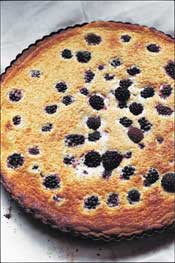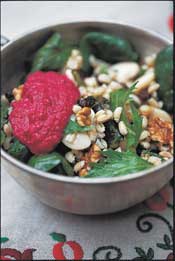EASTERN FEASTS - Blackberry and Buttermilk Tart / White Bean & Barley Salad with Beetroot & Yoghurt Dressing / Walnuts
 ‘Feasts’ (Mitchell Beazley, stg£20), a delightful new cookery book on the food of central and eastern Europe, has arrived on my desk and, given the number of people now living in Ireland who are native to those regions and – perhaps more surprisingly – the amount of ingredients that we share, it should find a niche here.
‘Feasts’ (Mitchell Beazley, stg£20), a delightful new cookery book on the food of central and eastern Europe, has arrived on my desk and, given the number of people now living in Ireland who are native to those regions and – perhaps more surprisingly – the amount of ingredients that we share, it should find a niche here.
There is a perception that Eastern European food is heavy and boring but Bulgarian-born author Silvena Rowe, who is acknowledged as a leading expert on the region, quickly dispels that myth with her pleasing collection of recipes and background information. The recipes she presents are a nicely balanced mixture of classics (borscht, gravad lax, herrings with sour cream, beef Stroganoff, stuffed cabbage leaves) and lesser known dishes like Georgian meatballs with pine nuts and sour cherries, pomegranate and plum-glazed racks of lamb and balsamic-roasted pears with honey.
Some dishes will strike a chord – blini are, of course, very like our griddle scones, and the blackberry and buttermilk tart given below could easily be from an Irish kitchen – and her appealing and accessible recipes will suggest many new uses for our own everyday ingredients.
Blackberry and Buttermilk Tart
This would be a nice hot dessert to try while blackberries are still there for the picking, and could easily be simplified to make a quicker everyday dish by using ready-made pastry.
Serves 8
225g / 8 oz plain flour
50g/13/4 oz caster sugar
115g/4 oz unsalted butter, chopped
¼ tsp almond essence
Buttermilk filling
2 large egg yolks
1 whole egg
70g/21/2 oz soft brown sugar
50g/13/4 oz vanilla sugar
seeds from 1 plump vanilla pod
1 tsp cornflour
250 ml/9 fl oz buttermilk
50 ml/2 fl oz double cream
500g/1 lb 2 oz blackberries.
Place the flour and sugar in a food processor and combine well. Add the butter and pulse in short bursts until the mixture resembles breadcrumbs. Add the almond essence and some water, if needed, for the pastry to come together.
Place the pastry dough in front of you on a floured work surface and knead gently. Wrap in clingfilm and place in the fridge for an hour.
When ready, roll out the pastry on a floured surface until 4 mm thick, and use it to line a tart dish of about 22-24cm (8-10 inches) in diameter. Cover and replace in the fridge for an hour.
Preheat the oven to 180’C/350’F/gas mark 4. Line the tart shell with baking paper and fill it with baking weights, or dried beans (keep in a jar for re-use another time). Blind-bake for 15 minutes. Remove the paper and weights and bake for another 5 minutes, until lightly browned.
To make the filling, whisk together the egg yolks, egg, sugar, vanilla sugar, vanilla seeds and flour. Gently heat the buttermilk and double cream together, and gently whisk into the egg mixture.
Place the blackberries in the tart shell and very carefully pour in the warm buttermilk mixture. Place in the oven, having reduced the heat to 160’C/325’F/gas mark 3, and bake for 35-40 minutes, until the buttermilk filling is firm.
SHORT RECIPE: White Bean & Barley Salad with Beetroot & Yoghurt Dressing
 Pulses and grains form an indispensable part of the cuisines of countries like Bulgaria, Hungary and Poland, and commonly used in everyday dishes, mainly soups and stews. For this salad any dried white beans like butter beans or haricots (soak and cook first) can be used, or canned beans, as here.
Pulses and grains form an indispensable part of the cuisines of countries like Bulgaria, Hungary and Poland, and commonly used in everyday dishes, mainly soups and stews. For this salad any dried white beans like butter beans or haricots (soak and cook first) can be used, or canned beans, as here.
Serves 4
1 x 400g can white beans, rinsed and drained
Beetroot and yoghurt sauce:
200g cooked barley (just boiled)
3 beetroots, washed
50g/ 2oz sultanas
2 garlic cloves, peeled and crushed
2 tbsp chopped fresh parsley
250ml / 9 fl oz thick yoghurt
2 tbsp chopped fresh thyme
30g / 1 oz ground walnuts
50g / 1 oz shelled walnuts, roughly chopped
salt and pepper
200g/ 7 oz baby salad leaves
Cook the beetroots in boiling water for about 20 minutes until soft. Cool, then peel and place the flesh in a food processor with the garlic and yoghurt. Pulse until it is all smooth and creamy. Pour into a bowl and stir in the ground walnuts.
In a large bowl, combine the beans, barley, sultanas, herbs and walnuts and mix well. Season to taste. Add the salad leaves and toss everything gently together.
Serve accompanied by the beetroot and yoghurt sauce.
INGREDIENT OF THE WEEK: WALNUTS
 WHAT ARE THEY?
WHAT ARE THEY?
A genus of 15 species of hardy deciduous trees grown commercially for their valuable timber and edible nuts, and as specimen trees in parks and large gardens. The nuts are used extensively in Eastern Europe, and in the Middle East and adjacent regions – they are used in Greek cookery and the Romans planted them wherever they marched; as it takes about 15 years of growth before edible nuts are produced, this was a clear statement of intent.
WHERE DO THEY COME FROM?
The common walnut, Juglans regia, is native to Eastern Europe and northern Asia, and can be grown throughout Europe; other varieties are grown in different areas, including North America. The oblong nuts are produced in autumn and are creamy and mid-flavoured when fresh, without the bitterness often associated with the older, drier nuts usually available here.
WHERE CAN I GET THEM?
You could bring supplies back when visiting countries where they are prolific, but you are not likely to find Irish grown walnuts. Any fresh nuts available in Ireland would come from private gardens and, in the unlikely event that you might be lucky enough to find them, it would be from farmers’ markets or small specialist shops with access to private supplies. However, the familiar dry walnuts are easily available from grocers and supermarkets; pale nuts without any broken pieces indicate quality and are worth paying for – dark ones tend to be bitter.
WHAT CAN I DO WITH THEM?
Walnuts are extremely versatile, but they have a high oil content (walnut oil is a wonderful richly-flavoured product, for use in dressings etc) and will therefore become rancid after some time in storage, so it is important to use them quite quickly and replace them often. Good quality nuts in peak condition are delicious raw - used in salads, for example, or to accompany cheese. They have a special affinity with blue cheese, pears and sweet foods like honey or treacle; as an ingredient, they can be used in a wide range of sweet and savoury dishes but should not be cooked at very high temperatures or they will burn and become bitter. In her Central and Eastern European cookbook, Feasts (see above), Silvena Rowe gives a number of interesting recipes, including aubergine & walnut ‘caviar’, and prune & walnut cheesecake.





There are currently no comments
Leave a comment
Not a member? Register for your free membership now!
Or leave a comment by logging in with: